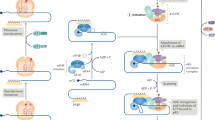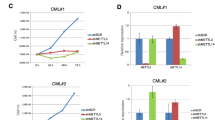Abstract
Accumulating evidence suggests that changes of the protein synthesis machinery alter translation of specific mRNAs and participate in malignant transformation. Here we show that protein kinase C α (PKCα) interacts with TRM61, the catalytic subunit of the TRM6/61 tRNA methyltransferase. The TRM6/61 complex is known to methylate the adenosine 58 of the initiator methionine tRNA (tRNAiMet), a nuclear post-transcriptional modification associated with the stabilization of this crucial component of the translation-initiation process. Depletion of TRM6/61 reduced proliferation and increased death of C6 glioma cells, effects that can be partially rescued by overexpression of tRNAiMet. In contrast, elevated TRM6/61 expression regulated the translation of a subset of mRNAs encoding proteins involved in the tumorigenic process and increased the ability of C6 cells to form colonies in soft agar or spheres when grown in suspension. In TRM6/61/tRNAiMet-overexpressing cells, PKCα overexpression decreased tRNAiMet expression and both colony- and sphere-forming potentials. A concomitant increase in TRM6/TRM61 mRNA and tRNAiMet expression with decreased expression of PKCα mRNA was detected in highly aggressive glioblastoma multiforme as compared with Grade II/III glioblastomas, highlighting the clinical relevance of our findings. Altogether, we suggest that PKCα tightly controls TRM6/61 activity to prevent translation deregulation that would favor neoplastic development.
This is a preview of subscription content, access via your institution
Access options
Subscribe to this journal
Receive 50 print issues and online access
$259.00 per year
only $5.18 per issue
Buy this article
- Purchase on Springer Link
- Instant access to full article PDF
Prices may be subject to local taxes which are calculated during checkout






Similar content being viewed by others
References
Jackson RJ, Hellen CU, Pestova TV . The mechanism of eukaryotic translation initiation and principles of its regulation. Nat Rev Mol Cell Biol 2010; 11: 113–127.
Sonenberg N, Hinnebusch AG . Regulation of translation initiation in eukaryotes: mechanisms and biological targets. Cell 2009; 136: 731–745.
Ron D, Harding HP . eIF2α phosphorylation in cellular stress responses and disease. Cold Spring Harbor Laboratory Press: New York,, 2007.
Lu PD, Harding HP, Ron D . Translation reinitiation at alternative open reading frames regulates gene expression in an integrated stress response. J Cell Biol 2004; 167: 27–33.
Thakor N, Holcik M . IRES-mediated translation of cellular messenger RNA operates in eIF2alpha- independent manner during stress. Nucleic Acids Res 2012; 40: 541–552.
Koromilas AE . Roles of the translation initiation factor eIF2alpha serine 51 phosphorylation in cancer formation and treatment. Biochim Biophys Acta 2014; 1849: 871–880.
Anderson J, Phan L, Cuesta R, Carlson BA, Pak M, Asano K et al. The essential Gcd10p-Gcd14p nuclear complex is required for 1-methyladenosine modification and maturation of initiator methionyl-tRNA. Genes Dev 1998; 12: 3650–3662.
Anderson J, Phan L, Hinnebusch AG . The Gcd10p/Gcd14p complex is the essential two-subunit tRNA(1-methyladenosine) methyltransferase of Saccharomyces cerevisiae. Proc Natl Acad Sci USA 2000; 97: 5173–5178.
Roovers M, Wouters J, Bujnicki JM, Tricot C, Stalon V, Grosjean H et al. A primordial RNA modification enzyme: the case of tRNA (m1A) methyltransferase. Nucleic Acids Res 2004; 32: 465–476.
Towns WL, Begley TJ, Transfer RNA . methytransferases and their corresponding modifications in budding yeast and humans: activities, predications, and potential roles in human health. DNA Cell Biol 2012; 31: 434–454.
Pavon-Eternod M, Gomes S, Rosner MR, Pan T . Overexpression of initiator methionine tRNA leads to global reprogramming of tRNA expression and increased proliferation in human epithelial cells. RNA 2013; 19: 461–466.
Quittau-Prevostel C, Delaunay N, Collazos A, Vallentin A, Joubert D . Targeting of PKCalpha and epsilon in the pituitary: a highly regulated mechanism involving a GD(E)E motif of the V3 region. J Cell Sci 2004; 117: 63–72.
Diouf B, Collazos A, Labesse G, Macari F, Choquet A, Clair P et al. A 20-amino acid module of protein kinase C{epsilon} involved in translocation and selective targeting at cell-cell contacts. J Biol Chem 2009; 284: 18808–18815.
Collazos A, Diouf B, Guerineau NC, Quittau-Prevostel C, Peter M, Coudane F et al. A spatiotemporally coordinated cascade of protein kinase C activation controls isoform-selective translocation. Mol Cell Biol 2006; 26: 2247–2261.
Rosse C, Linch M, Kermorgant S, Cameron AJ, Boeckeler K, Parker PJ . PKC and the control of localized signal dynamics. Nat Rev Mol Cell Biol 2010; 11: 103–112.
Gravitt KR, Ward NE, Fan D, Skibber JM, Levin B, O'Brian CA . Evidence that protein kinase C-alpha activation is a critical event in phorbol ester-induced multiple drug resistance in human colon cancer cells. Biochem Pharmacol 1994; 48: 375–381.
Budworth J, Gant TW, Gescher A . Co-ordinate loss of protein kinase C and multidrug resistance gene expression in revertant MCF-7/Adr breast carcinoma cells. Br J Cancer 1997; 75: 1330–1335.
Lee SK, Shehzad A, Jung JC, Sonn JK, Lee JT, Park JW et al. Protein kinase Calpha protects against multidrug resistance in human colon cancer cells. Mol Cells 2012; 34: 61–69.
Benzil DL, Finkelstein SD, Epstein MH, Finch PW . Expression pattern of alpha-protein kinase C in human astrocytomas indicates a role in malignant progression. Cancer Res 1992; 52: 2951–2956.
Misra-Press A, Fields AP, Samols D, Goldthwait DA . Protein kinase C isoforms in human glioblastoma cells. Glia 1992; 6: 188–197.
Xiao H, Goldthwait DA, Mapstone T . The identification of four protein kinase C isoforms in human glioblastoma cell lines: PKC alpha, gamma, epsilon, and zeta. J Neurosurg 1994; 81: 734–740.
Zellner A, Fetell MR, Bruce JN, De Vivo DC, O'Driscoll KR . Disparity in expression of protein kinase C alpha in human glioma versus glioma-derived primary cell lines: therapeutic implications. Clin Cancer Res 1998; 4: 1797–1802.
Mandil R, Ashkenazi E, Blass M, Kronfeld I, Kazimirsky G, Rosenthal G et al. Protein kinase Calpha and protein kinase Cdelta play opposite roles in the proliferation and apoptosis of glioma cells. Cancer Res 2001; 61: 4612–4619.
Cameron AJ, Procyk KJ, Leitges M, Parker PJ . PKC alpha protein but not kinase activity is critical for glioma cell proliferation and survival. Int J Cancer 2008; 123: 769–779.
Ahmad S, Mineta T, Martuza RL, Glazer RI . Antisense expression of protein kinase C alpha inhibits the growth and tumorigenicity of human glioblastoma cells. Neurosurgery 1994; 35: 904–908 (discussion 908–909).
Torres AG, Batlle E, Ribas de Pouplana L . Role of tRNA modifications in human diseases. Trends Mol Med 2014; 20: 306–314.
Ozanick S, Krecic A, Andersland J, Anderson JT . The bipartite structure of the tRNA m1A58 methyltransferase from S. cerevisiae is conserved in humans. RNA 2005; 11: 1281–1290.
Gruber JR, Desai S, Blusztajn JK, Niles RM . Retinoic acid specifically increases nuclear PKC alpha and stimulates AP-1 transcriptional activity in B16 mouse melanoma cells. Exp Cell Res 1995; 221: 377–384.
Saikia M, Fu Y, Pavon-Eternod M, He C, Pan T . Genome-wide analysis of N1-methyl-adenosine modification in human tRNAs. RNA 2010; 16: 1317–1327.
Kadaba S, Krueger A, Trice T, Krecic AM, Hinnebusch AG, Anderson J . Nuclear surveillance and degradation of hypomodified initiator tRNAMet in S. cerevisiae. Genes Dev 2004; 18: 1227–1240.
Ozanick SG, Wang X, Costanzo M, Brost RL, Boone C, Anderson JT . Rex1p deficiency leads to accumulation of precursor initiator tRNAMet and polyadenylation of substrate RNAs in Saccharomyces cerevisiae. Nucleic Acids Res 2009; 37: 298–308.
David A, Dolan BP, Hickman HD, Knowlton JJ, Clavarino G, Pierre P et al. Nuclear translation visualized by ribosome-bound nascent chain puromycylation. J Cell Biol 2012; 197: 45–57.
David A, Netzer N, Strader MB, Das SR, Chen CY, Gibbs J et al. RNA binding targets aminoacyl-tRNA synthetases to translating ribosomes. J Biol Chem 2011; 286: 20688–20700.
Pavon-Eternod M, Gomes S, Geslain R, Dai Q, Rosner MR, Pan T . tRNA over-expression in breast cancer and functional consequences. Nucleic Acids Res 2009; 37: 7268–7280.
Louis DN, Ohgaki H, Wiestler OD, Cavenee WK, Burger PC, Jouvet A et al. The 2007 WHO classification of tumours of the central nervous system. Acta Neuropathol 2007; 114: 97–109.
Reme T, Hugnot JP, Bieche I, Rigau V, Burel-Vandenbos F, Prevot V et al. A Molecular Predictor Reassesses Classification of Human Grade II/III Gliomas. PLoS One 2013; 8: e66574.
Balmain A, Harris CC . Carcinogenesis in mouse and human cells: parallels and paradoxes. Carcinogenesis 2000; 21: 371–377.
Whalen SG, Gingras AC, Amankwa L, Mader S, Branton PE, Aebersold R et al. Phosphorylation of eIF-4E on serine 209 by protein kinase C is inhibited by the translational repressors, 4E-binding proteins. J Biol Chem 1996; 271: 11831–11837.
Guan L, Song K, Pysz MA, Curry KJ, Hizli AA, Danielpour D et al. Protein kinase C-mediated down-regulation of cyclin D1 involves activation of the translational repressor 4E-BP1 via a phosphoinositide 3-kinase/Akt-independent, protein phosphatase 2 A-dependent mechanism in intestinal epithelial cells. J Biol Chem 2007; 282: 14213–14225.
Hou J, Lam F, Proud C, Wang S . Targeting Mnks for cancer therapy. Oncotarget 2012; 3: 118–131.
Welsh GI, Price NT, Bladergroen BA, Bloomberg G, Proud CG . Identification of novel phosphorylation sites in the beta-subunit of translation initiation factor eIF-2. Biochem Biophys Res Commun 1994; 201: 1279–1288.
Andaya A, Jia W, Sokabe M, Fraser CS, Hershey JW, Leary JA . Phosphorylation of human eukaryotic initiation factor 2 gamma: novel site identification and targeted PKC involvement. J Proteome Res 2011; 10: 4613–4623.
Alain T, Morita M, Fonseca BD, Yanagiya A, Siddiqui N, Bhat M et al. eIF4E/4E-BP ratio predicts the efficacy of mTOR targeted therapies. Cancer Res 2012; 72: 6468–6476.
Boussemart L, Malka-Mahieu H, Girault I, Allard D, Hemmingsson O, Tomasic G et al. eIF4F is a nexus of resistance to anti-BRAF and anti-MEK cancer therapies. Nature 2014; 513: 105–109.
Zindy P, Berge Y, Allal B, Filleron T, Pierredon S, Cammas A et al. Formation of the eIF4F translation-initiation complex determines sensitivity to anticancer drugs targeting the EGFR and HER2 receptors. Cancer Res 2011; 71: 4068–4073.
Marques JM, Rodrigues RJ, Valbuena S, Rozas JL, Selak S, Marin P et al. CRMP2 tethers kainate receptor activity to cytoskeleton dynamics during neuronal maturation. J Neurosci 2013; 33: 18298–18310.
Shevchenko A, Wilm M, Vorm O, Mann M . Mass spectrometric sequencing of proteins silver-stained polyacrylamide gels. Anal Chem 1996; 68: 850–858.
Chen C, Huang B, Eliasson M, Ryden P, Bystrom AS . Elongator complex influences telomeric gene silencing and DNA damage response by its role in wobble uridine tRNA modification. PLoS Genet 2011; 7: e1002258.
Bjork GR, Jacobsson K, Nilsson K, Johansson MJ, Bystrom AS, Persson OP . A primordial tRNA modification required for the evolution of life? EMBO J 2001; 20: 231–239.
Acknowledgements
This work was generously supported by the Institut National du Cancer (INCa) and the Fondation ARC. We thank Martial Seveno, Serge Urbach and Edith Demettre from the 'Plate-forme de Protéomique Fonctionnelle' (FPP) for their work on proteomic analysis of cell samples. We thank the Gustave Roussy Genomic Core Facility (Noemie Pata-Merci) and the Gustave Roussy Bioinformatic Core Facility (Guillaume Meurice). ASB is supported by grants from the Swedish Cancer Foundation (13 0301), Swedish Research Council (621-2012-3576) and Karin and Harald Silvanders Foundation (223-2808-12).
Author information
Authors and Affiliations
Corresponding authors
Ethics declarations
Competing interests
The authors declare no conflict of interest.
Additional information
Supplementary Information accompanies this paper on the Oncogene website
Supplementary information
Rights and permissions
About this article
Cite this article
Macari, F., El-houfi, Y., Boldina, G. et al. TRM6/61 connects PKCα with translational control through tRNAiMet stabilization: impact on tumorigenesis. Oncogene 35, 1785–1796 (2016). https://doi.org/10.1038/onc.2015.244
Received:
Revised:
Accepted:
Published:
Issue Date:
DOI: https://doi.org/10.1038/onc.2015.244
This article is cited by
-
Research progress of N1-methyladenosine RNA modification in cancer
Cell Communication and Signaling (2024)
-
Insights into the regulatory role of RNA methylation modifications in glioma
Journal of Translational Medicine (2023)
-
The epitranscriptome of high-grade gliomas: a promising therapeutic target with implications from the tumor microenvironment to endogenous retroviruses
Journal of Translational Medicine (2023)
-
Deciphering glioma epitranscriptome: focus on RNA modifications
Oncogene (2023)
-
Establishment of a N1-methyladenosine-related risk signature for breast carcinoma by bioinformatics analysis and experimental validation
Breast Cancer (2023)



